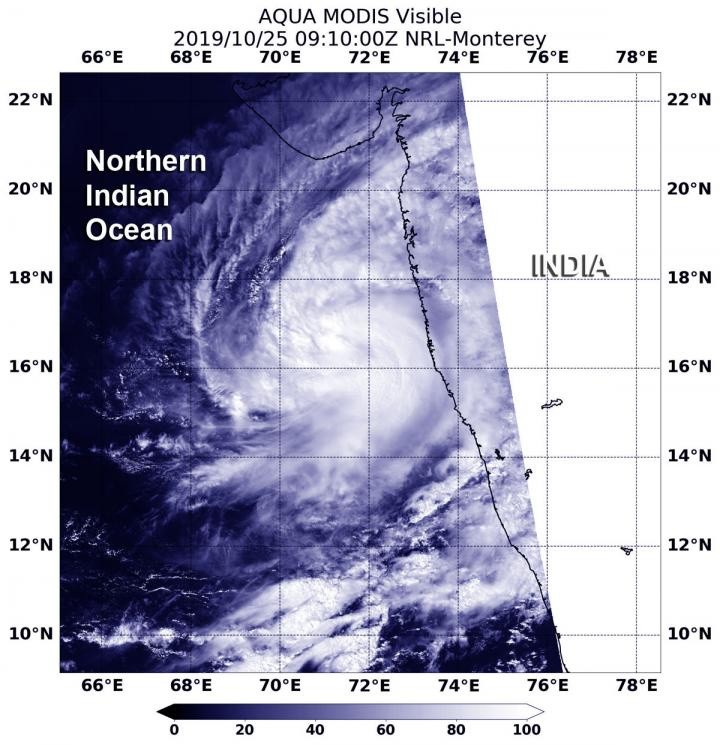
Tropical Storm Kyarr formed near the southwestern coast of India, and NASA's Aqua satellite provided forecasters with a visible image of the storm that revealed it organized quickly.
Kyarr formed early on Oct. 25 from a low-pressure area designated as System 97A in the northern Indian Ocean. Once the storm consolidated, it intensified quickly and became a tropical storm just off the southwest India coast.
The India Meteorological Department issued some warnings on Kyarr on Oct. 25. There is a heavy rainfall warning in effect that calls for light to moderate rainfall in most places. Heavy to very heavy falls are predicted at isolated places very likely over coastal districts of Karnataka, Goa and south Konkan and isolated heavy rainfall over north Konkan during next 24 hours. There is also a wind warning in effect calling for gale-force winds with speeds reaching 70-80 kph (43 to 50 mph) gusting to 90 kph (56 mph), prevailing around the system center over east-central Arabian Sea. It is very likely to increase gradually becoming 90-100 kph (56 to 62 mph).
On Oct. 25 at 5:10 a.m. EDT (0910 UTC), the Moderate Imaging Spectroradiometer or MODIS instrument that flies aboard NASA's Aqua satellite provided a visible image of Kyarr. The image showed that there is a large band of powerful thunderstorms circling Kyarr's low-level center of circulation. In addition, infrared satellite imagery showed that Kyarr has a solid core of strong convection - that is, rising air which forms the thunderstorms that make up a tropical cyclone, wrap around the low-level circulation center. Microwave satellite imagery revealed the storm had developed an eye, a sign of strengthening.
The shape of the storm is a clue to forecasters that a storm is either strengthening or weakening. If a storm takes on a more rounded shape it is getting more organized and strengthening. Conversely, if it becomes less rounded or elongated, it is a sign the storm is weakening.
At 11 a.m. EDT (1500 UTC) on Oct. 25, the Joint Typhoon Warning Center or JTWC noted Tropical Cyclone Kyarr was located near latitude 16.3 degrees north and longitude 71.9 degrees east, about 579 nautical miles south-southeast of Karachi, Pakistan. Maximum sustained winds were 55 knots (63 mph/102 kph).
Kyarr is drifting generally northward while located between two subtropical ridges (elongated areas of high pressure) located to the northwest and northeast of the tropical storm. As those ridges strengthen and build, Kyarr is forecast to turn to the northwest and rapidly intensify.
The JTWC expects the storm will peak after three days, but will then start to weaken on approach to the Oman coastline.
© 2025 NatureWorldNews.com All rights reserved. Do not reproduce without permission.





